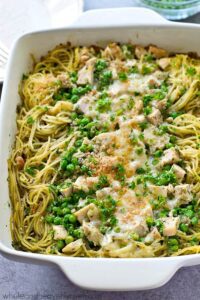Chicken Enchiladas is a delicious recipe that combines amazing flavors and textures.
Chicken Enchiladas represent the heart and soul of Mexican comfort food, combining tender shredded chicken, warm spices, and tangy sauce in a package that satisfies both the palate and the soul. This dish features corn tortillas filled with seasoned chicken, smothered in homemade enchilada sauce, and baked until the cheese is melted and bubbly. The result is a harmonious blend of textures and flavors—soft tortillas, savory filling, rich sauce, and creamy cheese—that creates a complete meal perfect for family dinners, potlucks, or festive gatherings.
What makes this dish exceptional is its versatility and adaptability. While rooted in Mexican culinary traditions, enchiladas have been embraced and adapted across borders, resulting in countless variations that reflect local ingredients and preferences. This version stays true to essential elements while allowing for customization based on spice tolerance and available ingredients. The homemade enchilada sauce provides depth and authenticity that canned versions cannot match, with the toasty flavor of chili powder blooming in oil creating the foundation for the complex sauce. The baking process allows the flavors to meld while creating textural contrast between the soft interior and slightly crisp edges.
The History of Enchiladas
Enchiladas have a long history in Mexican cuisine, dating back to Aztec times when people would eat corn tortillas wrapped around small fish. The word “enchilada” comes from the Spanish word “enchilar” meaning “to season with chili.” The modern version with sauce and cheese emerged in the 19th century as dairy products became more widely available in Mexico. The dish gained popularity in the United States during the mid-20th century as Mexican immigration increased and Tex-Mex cuisine developed.

This particular version represents a balance between authenticity and accessibility, using ingredients readily available in most supermarkets while maintaining the essential character of the dish. The use of both Monterey Jack and cotija cheeses reflects the fusion of Mexican and American dairy traditions, providing both meltability and authentic flavor. The homemade sauce allows control over spice level and quality, resulting in a superior product to canned alternatives.
Ingredient Selection Guide
Chili Powder Quality: Use high-quality, pure chili powder without added ingredients for the best flavor. Ancho chili powder provides mild heat and fruitiness, while New Mexico chili powder offers more heat. For complex flavor, use a blend of different chilies.
Tortilla Type: Corn tortillas provide authentic flavor and texture. Look for fresh, pliable tortillas rather than stiff, packaged ones. Warm briefly before rolling to prevent cracking. Flour tortillas can be used for a different texture.

Cheese Selection: Monterey Jack provides excellent meltability, while cotija adds authentic salty flavor. Other good melting cheeses include Asadero, Chihuahua, or mild cheddar. For authenticity, seek out Mexican cheese varieties.
Chicken Preparation: Use roasted or poached chicken for the best texture and flavor. The chicken should be shredded rather than chopped for better distribution. Save the cooking liquid to use in the sauce for extra flavor.
The Science of Sauce Making
The enchilada sauce is a roux-based sauce, which means it begins with cooking flour in fat to create a thickening agent. The chili powder and spices are bloomed in the oil, which releases their fat-soluble flavor compounds and creates a more complex flavor profile than adding them later. The liquid (chicken broth and tomato sauce) is added gradually to prevent lumps from forming.

The simmering process allows the starch molecules in the flour to swell and absorb liquid, thickening the sauce. The acid in the tomato sauce helps balance the richness while providing umami depth. The finished sauce should coat the back of a spoon—if too thick, add more broth; if too thin, simmer longer to reduce.
Step-by-Step Technique Mastery
Tortilla Preparation: Warm tortillas briefly in a dry skillet or microwave wrapped in damp paper towels. This makes them pliable and prevents cracking during rolling. Work with one tortilla at a time while keeping the others covered.
Filling Distribution: Place filling slightly off-center to make rolling easier. Do not overfill, which can cause bursting during baking. The amount will depend on tortilla size—about ¼ cup for standard tortillas.

Rolling Technique: Roll tortillas tightly but gently to avoid tearing. Place seam-side down in the baking dish to prevent unrolling. Pack them snugly in the dish to support each other.
Saucing Strategy: Spread a thin layer of sauce in the baking dish before adding enchiladas to prevent sticking. Sauce the top thoroughly but don’t drown the enchiladas—the sauce should coat them generously but not pool excessively.
Flavor Development Secrets
Enhance the filling by adding a tablespoon of chipotle in adobo for smokiness. A teaspoon of Mexican oregano provides more authentic flavor than Mediterranean oregano. Fresh epazote or cilantro stems add herbal complexity.
For extra depth, add a tablespoon of tomato paste to the filling and cook until it darkens slightly. A pinch of cinnamon or clove adds warmth that complements the chili. For brightness, add lime zest to the filling.
Infuse the sauce by steeping dried chilies instead of using powder. Toast dried ancho, guajillo, and pasilla chilies, then soak in hot water before blending into a smooth paste. This provides superior flavor complexity.
Professional Presentation Techniques
Create a beautiful presentation by arranging enchiladas neatly in the baking dish. Alternate directions for visual interest. Leave space between for even cooking and easy serving.
Garnish with fresh cilantro, radish slices, and avocado arranged artistically. Drizzle with crema in a zigzag pattern. Serve lime wedges on the side for diners to add brightness.
For individual servings, use smaller baking dishes or oven-safe plates. This creates restaurant-style presentation and ensures proper portion control. Serve immediately from the oven for best texture.
Nutritional Considerations
This dish provides protein from chicken, calcium from cheese, and various nutrients from the sauce ingredients. Corn tortillas offer fiber and are naturally gluten-free. However, it also contains significant sodium and saturated fat.
For a lighter version, use reduced-fat cheese, increase vegetable content in the filling, and use less oil in the sauce. Greek yogurt can substitute for crema. Serve with a large salad to balance the meal.
For gluten-free, use cornstarch instead of flour to thicken the sauce. Ensure all other ingredients are gluten-free. For dairy-free, use vegan cheese alternatives or simply omit the cheese topping.
Storage and Freshness Preservation
Unbaked assembled enchiladas can be refrigerated for up to 24 hours. Add 10-15 minutes to baking time if starting from cold. The sauce can be made ahead and refrigerated for up to 1 week or frozen for 3 months.
Leftovers can be refrigerated for 3-4 days. Reheat in the oven for best texture—microwaving can make tortillas soggy. The filling can be frozen for up to 3 months for quick future enchiladas.
Components can be prepared in stages: cook and shred chicken ahead, make sauce ahead, even assemble without baking ahead. This makes enchiladas perfect for entertaining or meal prep.
Cultural Significance and Modern Adaptations
Chicken Enchiladas represent the evolution of traditional Mexican cuisine in the global kitchen. They reflect how immigrant food traditions adapt to new environments while maintaining connection to their origins. The dish symbolizes comfort and celebration in Mexican culture, often served for family gatherings and special occasions.
Contemporary variations include different fillings (beef, pork, bean, vegetable), sauce variations (verde, mole, suiza), and creative toppings (fruit salsas, exotic cheeses, innovative garnishes). These adaptations demonstrate the versatility of the basic concept while honoring its essential character.
Final Thoughts
Chicken Enchiladas offer the perfect combination of comfort and flavor, tradition and adaptability. Their make-ahead convenience and crowd-pleasing nature make them perfect for both family dinners and entertaining. As you experience the harmony of tender chicken, warm spices, tangy sauce, and melted cheese, appreciate how this dish represents the rich culinary heritage of Mexico while adapting to modern tastes. May this recipe become a cherished part of your cooking repertoire, bringing warmth and satisfaction to your table.

Chicken Enchiladas
Ingredients
Method
- Heat olive oil in a skillet over medium heat
- Sauté onion until softened, about 5 minutes
- Add garlic and spices, cook for 1 minute until fragrant
- Add shredded chicken and ½ cup enchilada sauce
- Cook for 2-3 minutes until heated through
- Season with salt and pepper to taste
- Heat olive oil in a saucepan over medium heat
- Whisk in flour and cook for 1 minute until golden
- Add chili powder and spices, cook for 30 seconds
- Gradually whisk in chicken broth until smooth
- Stir in tomato sauce and simmer for 5 minutes
- Season with salt and pepper to taste
- Preheat oven to 375°F (190°C)
- Spread ½ cup sauce in a 9x13 inch baking dish
- Warm tortillas briefly to make pliable
- Spoon chicken filling onto each tortilla, roll tightly
- Place seam-side down in baking dish
- Pour remaining sauce over enchiladas
- Sprinkle with Monterey Jack cheese
- Cover with foil and bake for 20 minutes
- Remove foil and bake for 5 more minutes until bubbly
- Let stand for 5 minutes before serving
- Garnish with cotija cheese, cilantro, and avocado
- Serve with Mexican crema or sour cream



